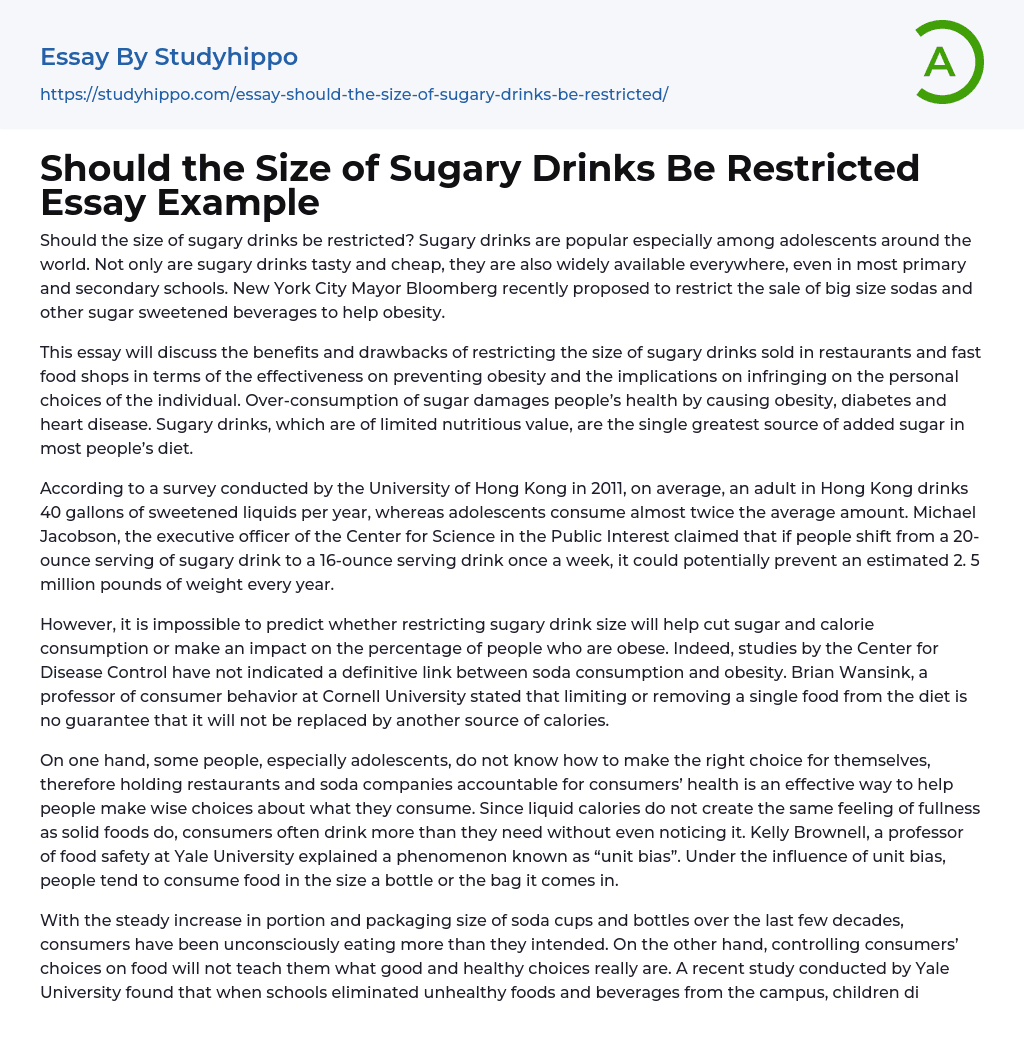Should the size of sugary drinks be restricted? Sugary drinks are popular especially among adolescents around the world. Not only are sugary drinks tasty and cheap, they are also widely available everywhere, even in most primary and secondary schools. New York City Mayor Bloomberg recently proposed to restrict the sale of big size sodas and other sugar sweetened beverages to help obesity.
This essay will discuss the benefits and drawbacks of restricting the size of sugary drinks sold in restaurants and fast food shops in terms of the effectiveness on preventing obesity and the implications on infringing on the personal choices of the individual. Over-consumption of sugar damages people’s health by causing obesity, diabetes and heart disease. Sugary drinks, which are of limited nutritious value, are the single greatest source of
...added sugar in most people’s diet.
According to a survey conducted by the University of Hong Kong in 2011, on average, an adult in Hong Kong drinks 40 gallons of sweetened liquids per year, whereas adolescents consume almost twice the average amount. Michael Jacobson, the executive officer of the Center for Science in the Public Interest claimed that if people shift from a 20-ounce serving of sugary drink to a 16-ounce serving drink once a week, it could potentially prevent an estimated 2. 5 million pounds of weight every year.
However, it is impossible to predict whether restricting sugary drink size will help cut sugar and calorie consumption or make an impact on the percentage of people who are obese. Indeed, studies by the Center for Disease Control have not indicated a definitive link between soda consumption and obesity
Brian Wansink, a professor of consumer behavior at Cornell University stated that limiting or removing a single food from the diet is no guarantee that it will not be replaced by another source of calories.
On one hand, some people, especially adolescents, do not know how to make the right choice for themselves, therefore holding restaurants and soda companies accountable for consumers’ health is an effective way to help people make wise choices about what they consume. Since liquid calories do not create the same feeling of fullness as solid foods do, consumers often drink more than they need without even noticing it. Kelly Brownell, a professor of food safety at Yale University explained a phenomenon known as “unit bias”. Under the influence of unit bias, people tend to consume food in the size a bottle or the bag it comes in.
With the steady increase in portion and packaging size of soda cups and bottles over the last few decades, consumers have been unconsciously eating more than they intended. On the other hand, controlling consumers’ choices on food will not teach them what good and healthy choices really are. A recent study conducted by Yale University found that when schools eliminated unhealthy foods and beverages from the campus, children did make healthier choices at school, but the obesity rate did not decline and were no different from schools without such bans.
Instead, the government and schools should work to educate the public and students on healthy choices provide more healthy options. It can be clearly seen that there are different opinions on whether or not restricting the size of sugary drinks
sold in restaurants and fast food shop will help establish a healthier community. However, it is more effective to educate the general public on how to make healthier choices rather than to take away the choices that they have.
- Alcoholic essays
- Soft Drinks essays
- Pregnancy essays
- Death essays
- Asthma essays
- Chronic Pain essays
- Diabetes essays
- Infection essays
- Infertility essays
- Pain essays
- Sexually Transmitted Disease essays
- Cholesterol essays
- Epidemic essays
- Pathogen essays
- Symptom essays
- Water supply essays
- Myocardial Infarction essays
- Chronic essays
- Hypertension essays
- Black Death essays
- Breast Cancer essays
- Down Syndrome essays
- Apoptosis essays
- Tuskegee Syphilis Experiment essays
- Type 2 Diabetes essays
- Causes Of Obesity essays
- Children Obesity essays
- Beef essays
- Beer essays
- Beverages essays
- Bread essays
- Burger essays
- Cake essays
- Coconut essays
- Coffee essays
- Cooking essays
- Crowd essays
- Cuisines essays
- Dairy essays
- Desserts essays
- Dinner essays
- Drink essays
- Fast Food essays
- Favorite Food essays
- Food Safety essays
- Food Security essays
- Food Waste essays
- Fruit essays
- Ginger essays
- Hamburger essays




